Dachau concentration camp
| Dachau | |
|---|---|
| Concentration camp | |
|
American troops guarding the main entrance to Dachau just after liberation, 1945 | |
 Location of Dachau in Upper Bavaria | |
| Coordinates | 48°16′08″N 11°28′07″E / 48.26889°N 11.46861°ECoordinates: 48°16′08″N 11°28′07″E / 48.26889°N 11.46861°E |
| Location | Upper Bavaria, Southern Germany |
| Operated by |
German Schutzstaffel (SS), U.S. Army (as internment camp after World War II) |
| Original use | Political prison |
| Operational | 1933–1945 |
| Number of gas chambers |
 Dachau Munich |
| Inmates | Poles, Russians, Ukrainians, French, Yugoslavs, Czechs, Germans, Austrians, Hungarians, Italians, Jews, Homosexuals, Jehovah’s Witnesses, Communists, Gypsies[1] |
| Number of inmates | over 188,000 (estimated)[2] |
| Killed | 31,951 (reported) |
| Liberated by | United States, 29 April 1945 |
| Website | Dachau Concentration Camp Memorial Site |
Dachau concentration camp (German: Konzentrationslager (KZ) Dachau, IPA: [ˈdaxaʊ]) was the first of the Nazi concentration camps opened in Germany, intended to hold political prisoners. It is located on the grounds of an abandoned munitions factory northeast of the medieval town of Dachau, about 16 km (10 mi) northwest of Munich in the state of Bavaria, in southern Germany.[3] Opened in 1933 by Heinrich Himmler, its purpose was enlarged to include forced labor, and eventually, the imprisonment of Jews, ordinary German and Austrian criminals, and eventually foreign nationals from countries that Germany occupied or invaded. The Dachau camp system grew to include nearly 100 sub-camps, which were mostly work camps or "Arbeitskommandos," and were located throughout southern Germany and Austria.[4] The camps were liberated by U.S. forces on 29 April 1945.
Prisoners lived in constant fear of brutal treatment and terror detention including standing cells, floggings, the so-called tree or pole hanging, and standing at attention for extremely long periods.[5] There were 32,000 documented deaths at the camp, and thousands that are undocumented.[6]
Approximately 10,000 of the 30,000 prisoners were sick at the time of liberation.[7][8]
In the postwar years the Dachau facility served to hold SS soldiers awaiting trial. After 1948, it held ethnic Germans who had been expelled from eastern Europe and were awaiting resettlement, and also was used for a time as a United States military base during the occupation. It was finally closed for use in 1960.
There are several religious memorials within the Memorial Site,[9] which is open to the public.
History
After the takeover of Bavaria on 9 March 1933, Heinrich Himmler, then Chief of Police in Munich, began to speak with the administration of an unused gunpowder and munitions factory. He toured the site to see if it could be used for quartering protective-custody prisoners. The Concentration Camp at Dachau was opened 22 March 1933, with the arrival of about 200 prisoners from Stadelheim Prison in Munich and the Landsberg fortress (where Hitler had written Mein Kampf during his imprisonment).[10] Himmler announced in the Münchner Neuesten Nachrichten newspaper that the camp could hold up to 5,000 people, and described it as "the first concentration camp for political prisoners"[3] to be used to restore calm to Germany.[11] It became the first regular concentration camp established by the coalition government of the National Socialist German Worker's Party (Nazi Party) and the German National People's Party (dissolved on 6 July 1933).
Jehovah’s Witnesses, homosexuals, and emigrants were sent to Dachau after the 1935 passage of the Nuremberg Laws which institutionalized racial discrimination.[12] In early 1937, the SS, using prisoner labor, initiated construction of a large complex capable of holding 6,000 prisoners. The construction was officially completed in mid-August 1938.[13] More political opponents, and over 11,000 German and Austrian Jews were sent to the camp after the annexation of Austria and the Sudetenland in 1938. Sinti and Roma in the hundreds were sent to the camp in 1939, and over 13,000 prisoners were sent to the camp from Poland in 1940.[12][14]
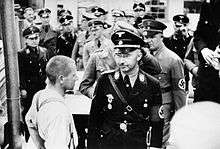
The prisoners of Dachau concentration camp originally were to serve as forced labor for a munition factory, and to expand the camp. It was used as a training center for SS guards and was a model for other concentration camps[15] The camp was about 300 m × 600 m (1,000 ft × 2,000 ft) in rectangular shape. The prisoner's entrance was secured by an iron gate with the motto “Arbeit macht frei” (“Work will make you free”). This reflected Nazi propaganda which trivialized concentration camps as labor and re-education camps, when in fact forced labor was used as a method of torture.[16]
As of 1938, the procedure for new arrivals occurred at the Schubraum, where prisoners were to hand over their clothing and possessions.[17] "There we were stripped of all our clothes. Everything had to be handed over: money, rings, watches. One was now stark naked".[18]
The camp included an administration building that contained offices for the Gestapo trial commissioner, SS authorities, the camp leader and his deputies; administration offices that consisted of large storage rooms for the personal belongings of prisoners; the bunker; roll-call square where guards would also inflict punishment on prisoners, especially those who tried to escape; the canteen, where prisoners served SS men with cigarettes and food; the museum containing plaster images of prisoners who suffered from bodily defects; the camp office; the library; the barracks; and the infirmary, which was staffed by prisoners who had previously held occupations such as physicians or army surgeons.[19]
Over 4,000 Soviet prisoners of war were murdered by the Dachau commandant's guard at the SS shooting range located two kilometers from the main camp in the years 1942/1943.[20][21][22] These murders were a clear violation of the provisions laid down in the Geneva Convention for prisoners of war. The SS used the cynical term "special treatment" for these criminal executions. The first executions of the Soviet prisoners of war at the Hebertshausen shooting range took place on 25 November 1941.[23]
After 1942, the number of prisoners regularly held at the camp continued to exceed 12,000.[24] Dachau originally held Communists, leading Socialists and other “enemies of the state” in 1933, but over time the Nazis began to send German Jews to the camp. In the early years of imprisonment, Jews were offered permission to emigrate overseas if they “voluntarily” gave their property to enhance Hitler’s public treasury.[24] Once Austria was annexed and Czechoslovakia was defeated, the citizens of both countries became the next prisoners at Dachau. In 1940, Dachau became filled with Polish prisoners, who constituted the majority of the prisoner population until Dachau was officially liberated.[25]

Prisoners were divided into categories. At first, they were classified by the nature of the crime for which they were accused, but eventually were classified by the specific authority-type under whose command a person was sent to camp.[26] Political prisoners who had been arrested by the Gestapo wore a red badge, "professional" criminals sent by the Criminal Courts wore a green badge, Cri-Po prisoners arrested by the criminal police wore a brown badge, "work-shy and asocial" people sent by the welfare authorities or the Gestapo wore a black badge, Jehovah’s Witnesses arrested by the Gestapo wore a violet badge, homosexuals sent by the criminal courts wore a pink badge, emigrants arrested by the Gestapo wore a blue badge, "race polluters" arrested by the criminal court or Gestapo wore badges with a black outline, second-termers arrested by the Gestapo wore a bar matching the color of their badge, "idiots" wore a white armband with the label Blöd (idiot), and Jews, whose incarceration in the Dachau concentration camp dramatically increased after Kristallnacht, wore a yellow badge, combined with another color.[27]
The prisoner enclosure at the camp was heavily guarded to ensure that no prisoners escaped. A 3-metre-wide (10 ft) no-man's land was the first marker of confinement for prisoners; an area which, upon entry would elicit lethal gunfire from guard towers. Guards are known to have tossed inmates' caps into this area, resulting in the death of the prisoners when they attempted to retrieve the caps. Despondent prisoners committed suicide by entering the zone. A four-foot-deep and eight-foot-broad (1.2 × 2.4 m) creek, connected with the river Amper, lay on the west side between the “neutral-zone” and the electrically charged, and barbed wire fence which surrounded the entire prisoner enclosure.[28]
Hundreds of prisoners suffered and died, or were executed in medical experiments conducted at KZ Dachau. Some of these experiments involved exposure to vats of icy water or being strapped down naked outdoors in freezing temperatures. Victims writhed in pain, foamed at the mouth, and lost consciousness. Attempts at reviving the subjects included scalding baths, and forcing naked women to copulate with the unconscious victim. Nearly 100 prisoners died during these experiments.[29] The original records of the experiments were destroyed "in an attempt to conceal the atrocities".[lower-alpha 1][30] Extensive communication between the investigators and Heinrich Himmler, head of the SS, was discovered, providing documentation of the experiments.[31] High altitude experiments were conducted during 1942. Victims were subjected to rapid decompression to pressures found at 4,300 metres (14,100 ft) and experienced spasmodic convulsions, agonal breathing, and eventual death.[32]
Prisoners were sent to KZ Dachau as late as 19 April 1945; on that date a freight train from Buchenwald with nearly 4,500 was diverted to Nammering. SS troops and police confiscated food and water local townspeople tried to give to the prisoners. Nearly three hundred dead bodies were ordered removed from the train and carried to a ravine over 400 metres (.25 mi) away. The 524 prisoners who had been forced to carry the dead to this site were then shot by the guards, and buried along with those who had died on the train. Nearly 800 bodies went into this mass grave. The train continued on to KZ Dachau.[33]
As U.S. troops drove deeper into Bavaria during April 1945, the commander of KZ Dachau suggested to Gestapo Chief Heinrich Himmler that the camp be turned over to the Allies. Himmler, in signed correspondence, prohibited such a move, adding that "No prisoners shall be allowed to fall into the hands of the enemy alive."[34]
Just days before the U.S. troops arrived at the camp the commandant and a strong guard forced between 6,000 and 7,000 inmates on a death march from Dachau south to Tegernsee. Any prisoners who could not keep up on the six day march were shot. Many others died of exhaustion, hunger and exposure.[35] Months later a mass grave containing 1,071 prisoners was found along the route.[36][37]
General overview
Dachau served as a prototype and model for the other Nazi concentration camps that followed. Almost every community in Germany had members taken away to these camps. Newspapers continually reported "the removal of the enemies of the Reich to concentration camps." As early as 1935, a jingle went around: "Dear God, make me dumb, That I may not to Dachau come" ("Lieber Herr Gott, mach mich stumm, Das ich nicht nach Dachau komm'").[38]

The camp's layout and building plans were developed by Kommandant Theodor Eicke and were applied to all later camps. He had a separate secure camp near the command center, which consisted of living quarters, administration, and army camps. Eicke became the chief inspector for all concentration camps, responsible for organizing others according to his model.[13]
The Dachau complex included the prisoners' camp, which occupied approximately 5 acres, and the much larger area of SS training school including barracks, factories, plus other facilities of around 20 acres.[39]
The entrance gate used by prisoners carries the phrase "Arbeit macht frei" (literal English translation: "Work makes free" (or "Work makes [one] free"; Contextual English translation: "Work shall set you free"). This phrase was also used in Terezín, near Prague, and Auschwitz I.
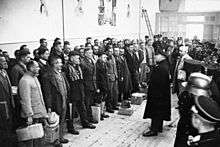
Dachau was the concentration camp that was in operation the longest from March 1933 to April 1945; nearly all twelve years of the Nazi regime. Dachau's close proximity to Munich, where Hitler came to power and where the Nazi Party had its official headquarters, made Dachau a convenient location. From 1933 to 1938, the prisoners were mainly German nationals detained for political reasons. After the Reichspogromnacht or Kristallnacht, 30,000 male Jewish citizens were deported to concentration camps. More than 10,000 of them were interned in Dachau alone. As the German military occupied other European states, citizens from across Europe were sent to concentration camps. Subsequently, the camp was used for prisoners of all sorts, from every nation occupied by the forces of the Third Reich.[40]
In the postwar years, the camp continued in use. From 1945 through 1948, the camp was used by the Allies as a prison for SS officers awaiting trial. After 1948, when hundreds of thousands of ethnic Germans were expelled from eastern Europe, it held Germans from Czechoslovakia until they could be resettled. It also served as a military base for the United States, which maintained forces in the country. It was closed in 1960. At the insistence of survivors, various memorials have been constructed and installed here.[41]
Demographic statistics vary but they are in the same general range. History will likely never know how many people were interned or died there, due to periods of disruption. One source gives a general estimate of over 200,000 prisoners from more than 30 countries for the Third Reich's years, of whom two-thirds were political prisoners, including many Catholic priests, and nearly one-third were Jews. 25,613 prisoners are believed to have died in the camp and almost another 10,000 in its subcamps,[42] primarily from disease, malnutrition and suicide. In early 1945, a typhus epidemic occurred in the camp caused by poor sanitation and overcrowding, followed by an evacuation, in which large numbers of the prisoners died. Toward the end of the war, death marches to and from the camp caused the deaths of numerous unrecorded prisoners. After liberation, prisoners weakened beyond recovery by the starvation conditions continued to die. Two thousand cases of "the dread black typhus" had already been identified by 3 May, and the U.S. Seventh Army was "working day and night to alleviate the appalling conditions at the camp".[43] Prisoners with typhus, a louse-borne disease with an incubation period from 12 to 18 days, were treated by the 116th Evacuation Hospital, while the 127th would be the general hospital for the other illnesses. There were 227 documented deaths among the 2,252 patients cared for by the 127th.[44]

Over the 12 years of use as a concentration camp, the Dachau administration recorded the intake of 206,206 prisoners and deaths of 31,951. Crematoria were constructed to dispose of the deceased. Visitors may now walk through the buildings and view the ovens used to cremate bodies, which hid the evidence of many deaths. It is claimed that in 1942, more than 3,166 prisoners in weakened condition were transported to Hartheim Castle near Linz, and were executed by poison gas because they were deemed unfit.[40][46] Between January and April 1945 11,560 detainees died at KZ Dachau.[47]
Together with the much larger Auschwitz concentration camp, Dachau has come to symbolize the Nazi concentration camps. Konzentrationslager (KZ) Dachau lives in public memory as the second camp to be liberated by British or American Allied forces. It was one of the first places that firsthand journalist accounts and newsreels revealed to the rest of the world.
Main camp
Purpose

Dachau was opened in March 1933.[3] The press statement given at the opening stated:
On Wednesday the first concentration camp is to be opened in Dachau with an accommodation for 5000 people. 'All Communists and—where necessary—Reichsbanner and Social Democratic functionaries who endanger state security are to be concentrated here, as in the long run it is not possible to keep individual functionaries in the state prisons without overburdening these prisons, and on the other hand these people cannot be released because attempts have shown that they persist in their efforts to agitate and organize as soon as they are released.[48]
Between the years 1933 and 1946, more than 3.5 million Germans were imprisoned in such concentration camps or prison for political reasons.[49][50][51] Approximately 77,000 Germans were killed for one or another form of resistance by Special Courts, courts-martial, and the civil justice system. Many of these Germans had served in government, the military, or in civil positions, which were considered to enable them to engage in subversion and conspiracy against the Nazis.[52]
Organization
The camp was divided into two sections: the camp area and the crematorium. The camp area consisted of 32 barracks, including one for clergy imprisoned for opposing the Nazi regime and one reserved for medical experiments. The courtyard between the prison and the central kitchen was used for the summary execution of prisoners. The camp was surrounded by an electrified barbed-wire gate, a ditch, and a wall with seven guard towers.[13]

In early 1937, the SS, using prisoner labor, initiated construction of a large complex of buildings on the grounds of the original camp. The construction was officially completed in mid-August 1938 and the camp remained essentially unchanged and in operation until 1945. A crematorium that was next to, but not directly accessible from within the camp, was erected in 1942. KZ Dachau was therefore the longest running concentration camp of the Third Reich. The Dachau complex included other SS facilities beside the concentration camp—a leader school of the economic and civil service, the medical school of the SS, etc. The camp at that time was called a "protective custody camp," and occupied less than half of the area of the entire complex.[13]
Demographics
The camp was originally designed for holding German and Austrian political prisoners and Jews, but in 1935 it began to be used also for ordinary criminals. Inside the camp there was a sharp division between the two groups of prisoners; those who were there for political reasons and therefore wore a red tag, and the criminals, who wore a green tag.[53] The political prisoners who were there because they disagreed with Nazi Party policies, or with Hitler, naturally did not consider themselves criminals. Dachau was used as the chief camp for Christian (mainly Catholic) clergy who were imprisoned for not conforming with the Nazi Party line.

During the war, other nationals were transferred to it, including French; in 1940 Poles; in 1941 people from the Balkans, Czechs, Yugoslavs; and in 1942, Russians.[53][53]
The average number of Germans in the camp during the war was 3,000. Just before the liberation many German prisoners were evacuated, but 2,000 of these Germans died during the evacuation transport. Evacuated prisoners included such prominent political and religious figures as Martin Niemöller, Kurt von Schuschnigg, Édouard Daladier, Léon Blum, Franz Halder and Hjalmar Schacht.[53]
In August 1944 a women's camp opened inside Dachau. In the last months of the war, the conditions at Dachau deteriorated. As Allied forces advanced toward Germany, the Germans began to move prisoners from concentration camps near the front to more centrally located camps. They hoped to prevent the liberation of large numbers of prisoners. Transports from the evacuated camps arrived continuously at Dachau. After days of travel with little or no food or water, the prisoners arrived weak and exhausted, often near death. Typhus epidemics became a serious problem as a result of overcrowding, poor sanitary conditions, insufficient provisions, and the weakened state of the prisoners.
Owing to repeated transports from the front, the camp was constantly overcrowded and the hygiene conditions were beneath human dignity. Starting from the end of 1944 up to the day of liberation, 15,000 people died, about half of all the prisoners held at KZ Dachau. Five hundred Soviet POWs were executed by firing squad. The first shipment of women came from Auschwitz-Birkenau.
Though at the time of liberation the death rate had peaked at 200 per day, after the liberation by U.S. forces the rate eventually fell to between 50 and 80 deaths per day. In addition to the direct abuse of the SS and the harsh conditions, people died from typhus epidemics and starvation. The number of inmates had peaked in 1944 with transports from evacuated camps in the east (such as Auschwitz), and the resulting overcrowding led to an increase in the death rate.[53]
Clergy
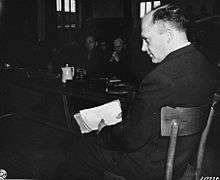
In effort to counter the strength and influence of spiritual resistance, Nazi security services monitored clergy very closely.[54]:141–2 Priests were frequently denounced, arrested and sent to concentration camps, often simply on the basis of being "suspected of activities hostile to the State" or that there was reason to "suppose that his dealings might harm society".[54]:142 Despite SS hostility to religious observance, the Vatican and German bishops successfully lobbied the regime to concentrate clergy at one camp and obtained permission to build a chapel, for the priests to live communally and for time to be allotted to them for the religious and intellectual activity. Priests Barracks at Dachau were established in Blocks 26, 28 and 30, though only temporarily. 26 became the international block and 28 was reserved for Poles – the most numerous group.[54]:145–6
Of a total of 2,720 clergy recorded as imprisoned at Dachau, the overwhelming majority, some 2,579 (or 94.88%) were Catholic. Among the other denominations, there were 109 Protestants, 22 Greek Orthodox, 8 Old Catholics and Mariavites and 2 Muslims. In his Dachau: The Official History 1933–1945, Paul Berben noted that R. Schnabel's 1966 investigation, Die Frommen in der Hölle ("The Pious Ones in Hell") found an alternative total of 2,771 and included the fate all the clergy listed, with 692 noted as deceased and 336 sent out on "invalid trainloads" and therefore presumed dead.[54]:276–277 Over 400 German priests were sent to Dachau.[55] Total numbers incarcerated are nonetheless difficult to assert, for some clergy were not recognised as such by the camp authorities, and some—particularly Poles—did not wish to be identified as such, fearing they would be mistreated.[54]:157
The Nazis introduced a racial hierarchy—keeping Poles in harsh conditions, while favouring German priests.[54]:148 697 Poles arrived in December 1941, and a further 500 of mainly elderly clergy were brought in October the following year. Inadequately clothed for the bitter cold, of this group only 82 survived. A large number of Polish priests were chosen for Nazi medical experiments. In November 1942, 20 were given phlegmons. 120 were used by Dr Schilling for malaria experiments between July 1942 and May 1944. Several Poles met their deaths with the "invalid trains" sent out from the camp, others were liquidated in the camp and given bogus death certificates. Some died of cruel punishment for misdemeanors—beaten to death or run to exhaustion.[54]:148–9
The Clergy Barracks of Dachau: Clergy by nationality[54]:276–277 Nationality Total number Released Transferred
elsewhereLiberated
29/4/45Deceased Poland 1,780 78 4 830 868 Germany 447 208 100 45 94 France 156 5 4 137 10 Czechoslovakia 109 1 10 74 24 Netherlands 63 10 36 17 Yugoslavia 50 2 6 38 4 Belgium 46 1 3 33 9 Italy 28 1 26 1 Luxembourg 16 2 8 6 Denmark 5 5 Lithuania 3 3 Hungary 3 3 Stateless 3 1 2 Switzerland 2 1 1 Greece 2 2 Britain 2 1 1 Albania 2 2 Norway 1 1 Romania 1 1 Spain 1 1 Total 2,720 314 132 1,240 1,034
Staff
The camp staff consisted mostly of SS males, although 19 female guards served at Dachau as well, most of them until liberation.[56] Sixteen have been identified including Fanny Baur, Leopoldine Bittermann, Ernestine Brenner, Anna Buck, Rosa Dolaschko, Maria Eder, Rosa Grassmann, Betty Hanneschaleger, Ruth Elfriede Hildner, Josefa Keller, Berta Kimplinger, Lieselotte Klaudat, Theresia Kopp, Rosalie Leimboeck, and Thea Miesl.[57] Women guards were assigned also to the Augsburg Michelwerke, Burgau, Kaufering, Mühldorf, and Munich Agfa Camera Werke subcamps. In mid-April 1945, female subcamps at Kaufering, Augsburg and Munich were closed, and the SS stationed the women at Dachau. Several Norwegians worked as guards at the Dachau camp.[58]
In the major Dachau war crimes case (United States of America v. Martin Gottfried Weiss et.al.), forty-two officials of Dachau were tried from November to December 1945. All were found guilty – thirty-six of the defendants were sentenced to death on December 13, 1945, of whom 23 were hanged on the May 28–29, 1946, including the commandant, SS-Obersturmbannführer Martin Gottfried Weiss, SS-Obersturmführer Freidrich Wilhelm Ruppert and camp doctors Karl Schilling and Fritz Hintermeyer.[59] Camp commandant Weiss admitted in affidavit testimony that most of the deaths at Dachau during his administration were due to “typhus, TB, dysentery, pneumonia, pleurisy, and body weakness brought about by lack of food.” His testimony also admitted to deaths by shootings, hangings and medical experiments.[60][61][62] Ruppert ordered and supervised the deaths of innumerable prisoners at Dachau main and subcamps, according to the War Crimes Commission official trial transcript. He testified about hangings, shootings and lethal injections, but did not admit to direct responsibility for any individual deaths.[63] An anonymous Dutch prisoner, who emerged in 1958, contended that British Special Operations Executive (SOE) agent Noor Inayat Khan was cruelly beaten by a high-ranking SS officer named Wilhelm Ruppert before being shot from behind; the beating may have been the actual cause of her death.[64]
Satellite camps and sub-camps
Satellite camps under the authority of Dachau were established in the summer and autumn of 1944 near armaments factories throughout southern Germany to increase war production. Dachau alone had more than 30 large subcamps in which over 30,000 prisoners worked almost exclusively on armaments.[65]
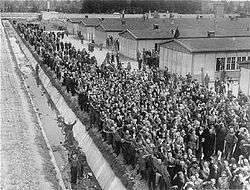
Overall, the Dachau concentration camp system included 123 sub-camps and Kommandos which were set up in 1943 when factories were built near the main camp to make use of forced labor of the Dachau prisoners. Out of the 123 sub-camps, eleven of them were called Kaufering, distinguished by a number at the end of each. All Kaufering sub-camps were set up to specifically build three underground factories (Allied bombing raids made it necessary for them to be underground) for a project called Ringeltaube (wood pigeon), which planned to be the location in which the German jet fighter plane, Messerschmitt Me 262, was to be built. In the last days of war, in April 1945, the Kaufering camps were evacuated and around 15,000 prisoners were sent up to the main Dachau camp. Typhus alone was estimated to have caused 15,000 deaths between December 1944 and April 1945.[66][67] "Within the first month after the arrival of the American troops, 10,000 prisoners were treated for malnutrition and kindred diseases. In spite of this one hundred prisoners died each day during the first month from typhus, dysentery or general weakness".[61]
As U.S. Army troops neared the Dachau sub-camp at Landsberg on 27 April 1945, the SS officer in charge ordered that 4,000 prisoners be murdered. Windows and doors of their huts were nailed shut. The buildings were then doused with gasoline and set afire. Prisoners who were naked or nearly so were burned to death, while some managed to crawl out of the buildings before dying. Earlier that day, as Wehrmacht troops withdrew from Landsberg am Lech, towns people hung white sheets from their windows. Infuriated SS troops dragged German civilians from their homes and hanged them from trees.[68][69]
Liberation
Main camp
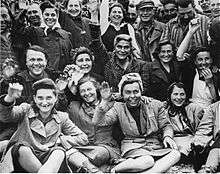
As the opposition began to advance on Nazi Germany, the SS began to evacuate the first concentration camps in summer 1944.[70] Thousands of prisoners were murdered before the evacuation due to being ill or unable to walk. At the end of 1944, the overcrowding of camps began to take its toll on the prisoners. The unhygienic conditions and the supplies of food rations became disastrous. In November a typhus fever epidemic broke out that took thousands of lives.[71]
In the second phase of the evacuation, in April 1945, Himmler gave direct evacuation routes for remaining camps. Prisoners that were from the northern part of Germany were to be directed to the Baltic and North Sea coasts to be drowned. The prisoners from the southern part were to be gathered in the Alps, which was the location in which the SS wanted to resist the Allies (p. 196). On 28 April 1945, an armed revolt took place in the town of Dachau. Both former and escaped concentration camp prisoners, and a renegade Volkssturm (civilian militia) company took part. At about 8:30 AM the rebels occupied the Town Hall. The advanced forces of the SS gruesomely suppressed the revolt within a few hours.[72]
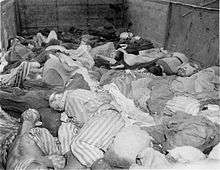
Being fully aware that Germany was about to be defeated in World War II, the SS invested its time in removing evidence of the crimes they committed in the concentration camps. The SS began destroying incriminating evidence in April 1945 and planned on murdering the prisoners using codenames “Wolke A I” (Cloud A I) and “Wolkenbrand” (Cloud fire). However, these plans never ended up being carried out. In mid-April, plans to evacuate the camp started by sending prisoners toward Tyrol. On 26 April, over 10,000 prisoners were forced to leave the Dachau concentration camp on foot, in trains, or in trucks. The largest group of some 7,000 prisoners was driven southward on a foot-march lasting several days. More than 1,000 prisoners did not survive this march. The evacuation transports cost many thousands of prisoners their lives.[73]
On 26 April 1945 prisoner Karl Riemer fled the Dachau concentration camp to get help from American troops and on 28 April Victor Maurer, a representative of the International Red Cross, negotiated an agreement to surrender the camp to U.S. troops. That night a secretly formed International Prisoners Committee took over the control of the camp. Units of 3rd Battalion, 157th Infantry Regiment, 45th Infantry Division, commanded by Lieutenant Colonel Felix L. Sparks, were ordered to secure the camp. On April 29 Sparks led part of his battalion as they entered the camp over a side wall.[74] At about the same time, Brigadier General Henning Linden led the 222nd Infantry Regiment of the 42nd (Rainbow) Infantry Division soldiers including his aide Lieutenant William Cowling[75] to accept the formal surrender of the camp from German Lieutenant Heinrich Wicker at an entrance between the camp and the compound for the SS garrison. Linden was traveling with Marguerite Higgins and other reporters, and as a result Linden's detachment generated international headlines by accepting the surrender of the camp. More than 30,000 Jews and political prisoners were freed, and since 1945 adherents of the 42nd and 45th Division versions of events have argued over which unit was the first to liberate Dachau.[76][77][78][79][80]
Satellite camps liberation
The first Dachau subcamp discovered by advancing Allied forces was Kaufering Lager IV at Landsberg am Lech by the 12th Armored Division on April 27, 1945.[81][82] Subcamps liberated by the 12th Armored Division included: Hurlach, Erpting, Kaufering, Schrosbenhausen, Schwabigg, Langerringen, Türkheim, Lawingen, Schwastach, Germering.[83] During the liberation of the sub-camps surrounding Dachau, advance scouts of the US Army's 522nd Field Artillery Battalion, a segregated battalion consisting of 2nd generation Nisei Japanese-Americans, liberated the 3,000 prisoners of the "Kaufering IV Hurlach"[84] slave labor camp.[85] Perisco describes an Office of Strategic Services (OSS) team (code name LUXE) leading Army Intelligence to a "Camp IV" on 29 April. "They found the camp afire and a stack of some four hundred bodies burning ... American soldiers then went into Landsberg and rounded up all the male civilians they could find and marched them out to the camp. The former commandant was forced to lie amidst a pile of corpses. The male population of Landsberg was then ordered to walk by, and ordered to spit on the commandant as they passed. The commandant was then turned over to a group of liberated camp survivors".[86] The 522nd's personnel later discovered the survivors of a death march[87] headed generally southwards from the Dachau main camp to Eurasburg, then eastwards towards the Austrian border on 2 May, nearest the town of Waakirchen.[88]
Weather at the time of liberation was unseasonably cool and temperatures trended down through the first two days of May; on May 2, the area received a snowstorm with 10 cm of snow at nearby Munich.[89] Proper clothing was still scarce and film footage from the time (as seen in The World at War) shows naked, gaunt people either wandering on snow or dead under it.
Due to the number of sub-camps over a large area that comprised the Dachau concentration camp complex, many Allied units have been officially recognized by the United States Army Center of Military History and the United States Holocaust Memorial Museum as liberating units of Dachau, including: the 4th Infantry Division, 36th Infantry Division, 42nd Infantry Division, 45th Infantry Division, 63rd Infantry Division, 99th Infantry Division, 103rd Infantry Division, 10th Armored Division, 12th Armored Division, 14th Armored Division, 20th Armored Division, and the 101st Airborne Division.[90]
Killing of camp guards
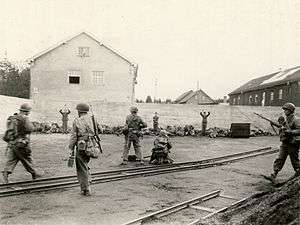
American troops killed some of the camp guards after they had surrendered. The number is disputed as some were killed in combat, some while attempting to surrender, and others after their surrender was accepted. In 1989 Brigadier General Felix L. Sparks, the Colonel in command of a battalion that was present, stated:
The total number of German guards killed at Dachau during that day most certainly does not exceed fifty, with thirty probably being a more accurate figure. The regimental records of the 157th Infantry Regiment (United States) for that date indicate that over a thousand German prisoners were brought to the regimental collecting point. Since my task force was leading the regimental attack, almost all the prisoners were taken by the task force, including several hundred from Dachau.[91]
An Inspector General report resulting from a US Army investigation conducted between 3 and 8 May 1945 and titled, "American Army Investigation of Alleged Mistreatment of German Guards at Dachau," found that 21 plus "a number" of presumed SS men were killed with others being wounded after their surrender had been accepted.[92][93] In addition, 25 to 50 SS guards were estimated to have been killed by the liberated prisoners.[94] Lee Miller visited the camp just after liberation, and photographed several guards who were killed by soldiers or prisoners.[95]
According to Sparks, court-martial charges were drawn up against him and several other men under his command but General George S. Patton (the then recently appointed military governor of Bavaria) chose to dismiss the charges.[91]
Colonel Charles L. Decker, an acting deputy judge advocate, concluded in late 1945 that, while war crimes had been committed at Dachau by Germany, "Certainly, there was no such systematic criminality among United States forces as pervaded the Nazi groups in Germany."[96]
American troops also forced local citizens to the camp to see for themselves the conditions there and to help bury the dead.[82] Many local residents were shocked about the experience and claimed no knowledge of the activities at the camp.[97]
Post-liberation Easter
6 May (23 April on the Orthodox calendar) was the day of Pascha, Orthodox Easter. In a cell block used by Catholic priests to say daily Mass, several Greek, Serbian and Russian priests and one Serbian deacon, wearing makeshift vestments made from towels of the SS guard, gathered with several hundred Greek, Serbian and Russian prisoners to celebrate the Paschal Vigil. A prisoner named Rahr described the scene:[98]
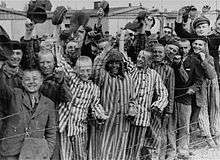
In the entire history of the Orthodox Church there has probably never been an Easter service like the one at Dachau in 1945. Greek and Serbian priests together with a Serbian deacon adorned the make-shift 'vestments' over their blue and gray-striped prisoners' uniforms. Then they began to chant, changing from Greek to Slavic, and then back again to Greek. The Easter Canon, the Easter Sticheras—everything was recited from memory. The Gospel—In the beginning was the Word—also from memory. And finally, the Homily of Saint John—also from memory. A young Greek monk from the Holy Mountain stood up in front of us and recited it with such infectious enthusiasm that we shall never forget him as long as we live. Saint John Chrysostomos himself seemed to speak through him to us and to the rest of the world as well!
There is a Russian Orthodox chapel at the camp today, and it is well known for its icon of Christ leading the prisoners out of the camp gates. The U.S. 7th Army's version of the events of the Dachau Liberation is available in Report of Operations of the Seventh United States Army, Vol. 3, page 382.
After liberation
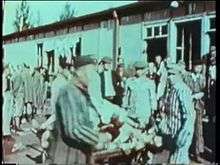
Authorities worked night and day to alleviate conditions at the camp immediately following the liberation as an epidemic of black typhus swept through the prisoner population. Two thousand cases had already been reported by that May 3.[99]
By October of the same year the camp was being used by the US Army as a place of confinement for war criminals, the SS and important witnesses.[100] It was also the site of the Dachau Trials for German war criminals, a site chosen for its symbolism. In 1948 the Bavarian government established housing for refugees on the site, and this remained for many years.[101] Among those held in the Dachau internment camp set up under the U.S. Army were Elsa Ehrich, Maria Mandl, and Elisabeth Ruppert.
Deportation of Soviet nationals
By January 1946 18,000 members of the SS were being confined at the camp along with an additional 12,000 persons, including deserters from the Russian army. The occupants of one barracks rioted as 271 of the Russian deserters were to be loaded onto trains that would return them to Russian-controlled lands, as agreed at the Yalta Conference. Ten of the soldiers, who had been captured in German Army uniforms, committed suicide during the riot. Twenty-one others attempted suicide, apparently with razor blades. Many had "cracked heads" inflicted by 500 American and Polish guards, in the attempt to bring the situation under control. Inmates barricaded themselves inside and set fire to the building, tore off their clothing, and linked arms to resist being removed from the building. Some begged American soldiers to shoot them. Tear gas was used by the soldiers before rushing the building.[102]
There were 275 cases of suicide or attempted suicide, whether by hanging, smashing window panes and cutting their throats on the shards of glass, or throwing themselves into the flames of their burning barracks.[103][104]
The Kaserne quarters and other buildings used by the guards and trainee guards were converted and served as the Eastman Barracks, an American military post, for many years. It had its own elementary school: Dachau American Elementary School, a part of the US Department of Defense dependent school system.
After the closure of the Eastman Barracks, these areas are now occupied by the Bavarian Bereitschaftspolizei (rapid response police unit).[105]
List of personnel

Commandants
- SS-Standartenführer Hilmar Wäckerle (22 March 1933 – 26 June 1933)
- SS-Gruppenführer Theodor Eicke (26 June 1933 – 4 July 1934)
- SS-Oberführer Alexander Reiner (4 July 1934 – 22 October 1934)
- SS-Brigadeführer Berthold Maack (22 October 1934 – 12 January 1935)
- SS-Oberführer Heinrich Deubel (12 January 1935 – 31 March 1936)
- SS-Oberführer Hans Loritz (31 March 1936 – 7 January 1939)
- SS-Hauptsturmführer Alex Piorkowski (7 January 1939 – 2 January 1942)
- SS-Obersturmbannführer Martin Weiß (3 January 1942 – 30 September 1943)
- SS-Hauptsturmführer Eduard Weiter (30 September 1943 – 26 April 1945)
- SS-Obersturmbannführer Martin Weiß (26 April 1945 – 28 April 1945)
- SS-Untersturmführer Johannes Otto (28 April 1945)
- SS-Untersturmführer Heinrich Wicker (28 April 1945 – 29 April 1945)
Other staff
- Adolf Eichmann (29 January 1934 – October 1934)[106] (Eichmann claimed that his unit had nothing to do with the concentration camp)[107]
- Rudolf Höss (1934–1938)[108]
- Max Kögel (1937–1938)
- Gerhard Freiherr von Almey, a SS-Obergruppenführer, half-brother of Ludolf von Alvensleben. Executed in 1955, in Moscow.
- Johannes Heesters[109] (visited the camp and entertained the SS-officers, was also given/giving tours)[110]
SS and civilian doctors

- SS-Untersturmführer – Dr. Hans Eisele – (13 March 1912 – 1967) – Escaped to Egypt
- SS-Obersturmführer – Dr. Fritz Hintermayer – (28 Oct 1911 – 29 May 1946) – Executed by the Allies
- Dr. Ernst Holzlöhner – (Committed suicide)
- SS-Hauptsturmführer – Dr. Fridolin Karl Puhr – (30 April 1913 – ?) – Sentenced to death, later commuted to 10-years imprisonment
- SS-Untersturmführer Dr. Sigmund Rascher – (12 February 1909 – 26 April 1945) – Executed by the SS
- Dr. Claus Schilling – (25 July 1871 – 28 May 1946) – Executed by the Allies
- SS Sturmbannführer – Dr. Horst Schumann – (11 May 1906 – 5 May 1983) – Escaped to Ghana, later extradited to West Germany
- SS Obersturmführer – Dr. Helmuth Vetter – (21 March 1910 – 2 February 1949) – Executed by the Allies
- SS Sturmbannführer – Dr. Wilhelm Witteler – (20 April 1909 – ?) – Sentenced to death, later commuted to 20-years imprisonment
- SS Sturmbannführer – Dr. Waldemar Wolter – (19 May 1908 – 28 May 1947) – Executed by the Allies
List of notable prisoners
Clergy
Dachau had a special "priest block." Of the 2720 priests (among them 2579 Catholic) held in Dachau, 1034 did not survive the camp. The majority were Polish (1780), of whom 868 died in Dachau.
- Serbian Patriarch Gavrilo V of the Serbian Orthodox Church, imprisoned in Dachau from September to December 1944
- a number of the Polish 108 Martyrs of World War II:
- Father Jean Bernard (1907–1994), Roman Catholic priest from Luxembourg who was imprisoned from May 1941 to August 1942. He wrote the book Pfarrerblock 25487 about his experiences in Dachau
- Blessed Titus Brandsma, Dutch Carmelite priest and professor of philosophy, died 26 July 1942
- Norbert Čapek (1870–1942) founder of the Unitarian Church in the Czech Republic
- Blessed Stefan Wincenty Frelichowski, Polish Roman Catholic priest, died 23 February 1945
- August Froehlich, German Roman Catholic priest, he protected the rights of the German Catholics and the maltreatment of Polish forced labourers
- Hilary Paweł Januszewski
- Ignacy Jeż later a Catholic Bishop
- Joseph Kentenich, founder of the Schoenstatt Movement, spent three and a half years in Dachau
- Bishop Jan Maria Michał Kowalski, the first Minister Generalis (Minister General) of the order of the Mariavites. He perished on 18 May 1942, in a gas chamber in Schloss Hartheim.
- Adam Kozlowiecki, later a Polish Cardinal
- Max Lackmann, Lutheran pastor and founder of League for Evangelical-Catholic Reunion.
- Blessed Karl Leisner, in Dachau since 14 December 1941, liberated 4 May 1945, but died on 12 August from tuberculosis contracted in the camp
- Josef Lenzel, German Roman Catholic priest, helped the Polish forced labourers
- Bernhard Lichtenberg – German Roman Catholic priest, was sent to Dachau but died on his way there in 1943
- Martin Niemöller, imprisoned in 1941, liberated 4 May 1945
- Nikolai Velimirović, bishop of the Serbian Orthodox Church and an influential theological writer, venerated as saint in the Eastern Orthodox Church.
- Lawrence Wnuk
- Nanne Zwiep, Pastor of the Dutch Reformed Church in Enschede, spoke out from the pulpit against Nazis and their treatment of Dutch Citizens and anti-Semitism, arrested 20 April 1942, died in Dachau of exhaustion and malnutrition 24 November 1942
More than two dozen members of the Religious Society of Friends (known as Quakers) were interned at Dachau. They may or may not have been considered clergy by the Nazis, as all Quakers perform services which in other Protestant denominations are considered the province of clergy. Over a dozen of them were murdered there.
Communists
- Alfred Andersch, held 6 months in 1933
- Hans Beimler, imprisoned but escaped. Died in the Spanish Civil War.
- Emil Carlebach (Jewish), in Dachau since 1937, sent to Buchenwald concentration camp in 1938
- Alfred Haag, In Dachau from 1935 to 1939, when moved to Mauthausen
- Adolf Maislinger
- Oskar Müller, in Dachau from 1939, liberated 1945
- Walter Vielhauer
- Nikolaos Zachariadis (Greek), from November 1941 to May 1945
Jewish
- Hinko Bauer, notable Croatian architect
- Bruno Bettelheim, imprisoned in 1938, freed in 1939; left Germany
- Jakob Ehrlich, Member of Vienna's City Council (Rat der Stadt Wien), died in Dachau 17 May 1938
- Viktor Frankl, neurologist and psychiatrist from Vienna, Austria
- Henry P. Glass, Austrian Architect and Industrial Designer, transferred to Buchenwald in September 1938.
- Zvi Griliches – Notable American economist
- Yanek (Jack) Gruener, a Polish boy whose story is told in Prisoner B-3087[111]
- Ludwig Kahn, German World War I Veteran and Entrepreneur from 29 Karls Street, Weilheim, Bavaria imprisoned 10 November 1938, freed 19 December 1938
- Hans Litten, anti-Nazi lawyer, died in 1938 by apparent suicide
- Aaron Miller, rabbi, chazzan, mohel
- Henry Morgentaler, also survived the Łódź Ghetto, later emigrated to Canada and became central to the abortion-rights movement there
- Alfred Müller, known Croatian entrepreneur from Zagreb
- Benzion Miller, born at the camp, son of Aaron Miller
- Sol Rosenberg, participated in the Warsaw Ghetto uprising; sent to Dachau; liberated from the camp in 1945; relocated to the United States
- Moshe Sanbar, Governor of the Bank of Israel
- Vladek Spiegelman, a survivor whose story was portrayed in the book Maus by son Art Spiegelman
Politicians
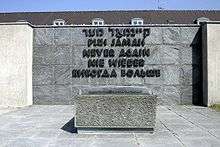
- Léon Blum – briefly, having been evacuated from Buchenwald concentration camp
- Jan Buzek, murdered in November 1940
- Theodor Duesterberg, briefly imprisoned in 1934
- Leopold Figl, arrested 1938, released 8 May 1943
- Andrej Gosar, Slovenian politician and political theorist, arrested in 1944
- Karl Haushofer
- Miklós Horthy, Jr.
- Alois Hundhammer, arrested 21 June 1933, freed 6 July 1933
- Miklós Kállay
- Franz Olah, arrested in 1938 and transported on the first train of Austrian prisoners to Dachau.[112]
- Hjalmar Schacht, arrested 1944, liberated April 1945
- Richard Schmitz
- Kurt Schumacher, in Dachau since July 1935, sent to Flossenbürg concentration camp in 1939, returned to Dachau in 1940, released due to extreme illness 16 March 1943
- Kurt Schuschnigg, the last fascist chancellor of Austria before the Austrian Nazi Party was installed by Hitler, shortly before the Anschluss
- Stefan Starzyński, the Mayor of Warsaw, probably murdered in Dachau in 1943
- Petr Zenkl, Czech national socialist politician
Resistance fighters
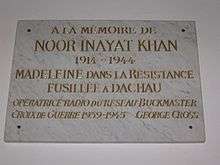
- Yolande Beekman, Special Operations Executive Agent, murdered 13 September 1944
- Georges Charpak, who in 1992 received the Nobel Prize in Physics
- Madeleine Damerment, Special Operations Executive Agent, murdered 13 September 1944
- Charles Delestraint, French General and leader of French resistance; executed by Gestapo in 1945
- Georg Elser, who tried to assassinate Hitler in 1939, murdered 9 April 1945
- Arthur Haulot
- Noor Inayat Khan, the George's Cross awardee of Indian origin who served as a clandestine radio operator for the Special Operations Executive in Paris, murdered 13 September 1944 when she and her SOE colleagues were shot in the back of the head and cremated
- George Maduro, Dutch law student and cavalry officer posthumously awarded the medal of Knight 4th-class of the Military Order of William.
- Kurt Nehrling, murdered in 1943
- Eliane Plewman, Special Operations Executive Agent, murdered 13 September 1944
- Enzo Sereni, Special Operations Executive Agent, Jewish, son of King Victor Emmanuele's personal physician. Parachuted into Nazi-occupied Italy, captured by the Germans and executed in November 1944. Kibbutz Netzer Sereni in Israel is named after him.
- Jean ("Johnny") Voste, the one documented black prisoner, was a Belgian resistance fighter from the Belgian Congo; he was arrested in 1942 for alleged sabotage and was one of the survivors of Dachau[113][114][115]
Royalty
- Antonia, Crown Princess of Bavaria
- Albrecht, Duke of Bavaria
- Princess Irmingard of Bavaria
- Franz, Duke of Bavaria
- Grand Duchess Kira Kirillovna of Russia
- Prince Louis Ferdinand of Prussia
- Prince Max, Duke in Bavaria
- Philipp, Landgrave of Hesse
- Franz Wittelsbach, Prinz von Bayern
- Maximilian, Duke of Hohenberg
- Prince Ernst von Hohenberg
Scientists
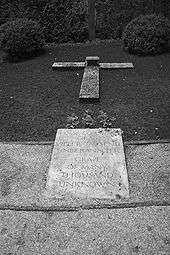
Among many others, 183 professors and lower university staff from Kraków universities, arrested on 6 November 1939 during Sonderaktion Krakau.
Writers
- Fran Albreht, Slovenian poet
- Robert Antelme, French writer
- Raoul Auernheimer, writer, in Dachau 4 months
- Tadeusz Borowski, writer, survived, but committed suicide in 1951
- Adolf Fierla, Polish poet
- Viktor Frankl, an Austrian psychiatrist and writer
- Fritz Gerlich, a German journalist
- Stanisław Grzesiuk, Polish writer, poet and singer, in Dachau from 4 April 1940, later transferred to Mauthausen
- Heinrich Eduard Jacob, German writer, in Dachau 6 months in 1938, transferred to Buchenwald
- Stefan Kieniewicz, Polish historian
- Juš Kozak, Slovenian playwright
- Friedrich Bernhard Marby, German occult writer
- Gustaw Morcinek, Polish writer
- Boris Pahor, Slovenian writer
- Karol Piegza, Polish writer, teacher and folklorist
- Gustaw Przeczek, Polish writer and teacher
- Friedrich Reck-Malleczewen, German writer
- Franz Roh, German art critic and art historian, for a few months in 1933
- Jura Soyfer, writer, in Dachau 6 months in 1938, transferred to Buchenwald
- Adam Wawrosz, Polish poet and writer
- Stanislaw Wygodzki, Polish writer
- Stevo Žigon (number: 61185), Serbian actor, theatre director, and writer, in Dachau from December 1943 to May 1945
Military
- Konstantinos Bakopoulos, Greek general
- Bogislaw von Bonin, Wehrmacht officer, opponent
- Panagiotis Dedes, Greek general
- Franz Halder, former Chief of German Army General Staff
- Georgios Kosmas, Greek general
- Alexander Papagos, commander-in-chief of the Greek Army in 1940–41, future Prime Minister of Greece
- Ernest Peterlin, Slovenian military officer
- Ioannis Pitsikas, Greek general
- Georgios Tsouris, Greek officer, resistance fighter from Crete
Others
- Titus Brandsma, Dutch priest, philosopher and former rector of Nijmegen University
- Jan Ertmański, Polish boxer who competed in the 1924 Summer Olympics
- Alexander von Falkenhausen, German general who resisted Hitler
- Brother Theodore, comedian
- Bruno Franz Kaulbach, Austrian lawyer
- Zoran Mušič, Slovenian painter
- Ona Šimaitė, Lithuanian librarian
- Tullio Tamburini, Italian police chief
- Fritz Thyssen, businessman and early supporter of Hitler, later an opponent
- Morris Weinrib, father of Rush singer, bassist, keyboardist Geddy Lee
- Władysław Dworaczek, Polish educator
Gallery
-

The camp courtyard
-

Memorial to the victims of Dachau
-
The Crematorium
-

New crematorium
-

Original crematorium
-
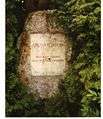
The sign outside the building Crematorium says in German: "Think about how we died here"
-

Protestant Church of Reconciliation
-

Catholic Mortal Agony of Christ chapel
-

Jewish Memorial
-

Tower
-
The Perimeter Fence
-
View of roll-call area
-

Prisoner bunks
-

Prisoner toilets
-

The entrance and the northern part of the "Bunker"
-
The east wing of the "Bunker" (camp prison), normally closed to visitors
-

Sign on the gravel road leading to the entrance
KZ-Gedenkstätte Dachau Concentration Camp Memorial Site

Between 1945 and 1948 when the camp was handed over to the Bavarian authorities, many accused war criminals and members of the SS were imprisoned at the camp.
Owing to the severe refugee crisis mainly caused by the expulsions of ethnic Germans, the camp was from late 1948 used to house 2000 Germans from Czechoslovakia (mainly from the Sudetenland). This settlement was called Dachau-East, and remained until the mid-1960s.[116] During this time, former prisoners banded together to erect a memorial on the site of the camp, finding it unbelievable that there were still people (refugees) living in the former camp.
The display, which was reworked in 2003, takes the visitor through the path of new arrivals to the camp. Special presentations of some of the notable prisoners are also provided. Two of the barracks have been rebuilt and one shows a cross-section of the entire history of the camp, since the original barracks had to be torn down due to their poor condition when the memorial was built. The other 32 barracks are indicated by concrete foundations. The memorial includes four chapels for the various religions represented among the prisoners.
In popular culture
Literature
- In his 2013 autobiography, Moose: Chapters from My Life, in the chapter entitled, "Dachau", author Robert B. Sherman chronicles his experiences as an American Army serviceman during the initial hours of Dachau's liberation.[117]
- In The Book Thief, Max Vandenburg - along with many other Jews - are led through the street toward Dachau in front of all the German onlookers, including the protagonist, Liesel.
- In the short novel Down the Highway by Michael Corrigan, two young American men traveling through Europe in 1962 visit Dachau.
- In Prisoner B-3087, it is one of the many concentration camps Yanek (who now goes by the name of Jack) is sent to.
Onscreen
- In the Family Guy episode "McStroke" The McBurgertown slaughterhouse is referred to as "Dacow" in reference to the concentration camp in Dachau, Germany.
- Dachau is depicted as the setting for The Twilight Zone episode "Deaths-Head Revisited" (1961), in which a former SS captain revisits the place he once worked in and the ghosts of the men who died there.
- Frontline: "Memory of the Camps" (7 May 1985, Season 3, Episode 18), is a 56-minute television documentary that addresses Dachau and other Nazi concentration camps[118][119]
- The Dachau Massacre figures prominently in the back story of Teddy Daniels, the protagonist of Dennis Lehane's psychological mystery-thriller Shutter Island, (2003) (later adapted into a 2010 film by Martin Scorsese, starring Leonardo DiCaprio). Among other memories, Daniels is haunted by his own recollections of the massacre and taking part in the executions after seeing piles of prisoners' bodies.
In music
- "Dachau Blues", a song by psychedelic blues singer Captain Beefheart from the album Trout Mask Replica (1969), contains several references to the camp and to the Holocaust.
- The British band The Style Council released a song called "Ghosts of Dachau" (1984) in memory of those who died at Dachau, after a visit by lead singer Paul Weller to a concentration camp.
In theatre
- Dachau is the concentration camp in which two homosexual prisoners desperately try to hold on to their humanity in the play Bent (1979) by Martin Sherman.
In games
- Sites within Dachau and Sachsenhausen which had been approved for inclusion in the augmented reality smartphone game Ingress were removed in July 2015; Gabriele Hammermann, director of the memorial site at Dachau, told the Deutsche Presse-Agentur that Google's actions were a humiliation for victims and relatives of the Nazi camps, and Niantic Labs' founder John Hanke stated that "we apologize that this has happened".[120]
See also
Notes
- ↑ "In an attempt to conceal the atrocities, the original, incriminating records of most of the concentration camp studies of humans were destroyed before the camps were captured by the Allied forces." (See Medicine, Ethics, and the Third Reich: Historical and Contemporary Issues Page 88)
- ↑ The caption for the photograph in the U.S. National Archives reads, "SC208765, Soldiers of the 42nd Infantry Division, U.S. Seventh Army, order SS men to come forward when one of their number tried to escape from the Dachau, Germany, concentration camp after it was captured by U.S. forces. Men on the ground in background feign death by falling as the guards fired a volley at the fleeing SS men. (157th Regt. 4/29/45)."
References
- ↑ "Dachau - 7th Army Official Report, May 1945". TankDestroyer.net. May 1945. Archived from the original on 30 January 2016. Retrieved 30 January 2016.
- ↑ "Holocaust Encyclopedia - Dachau". United States Holocaust Memorial Museum, Washington, DC. Retrieved 30 January 2016.
- 1 2 3 "Ein Konzentrationslager für politische Gefangene In der Nähe von Dachau". Münchner Neueste Nachrichten ("The Munich Latest News") (in German). The Holocaust History Project. 21 March 1933.
The Munich Chief of Police, Himmler, has issued the following press announcement: On Wednesday the first concentration camp is to be opened in Dachau with an accommodation for 5000 persons. 'All Communists and—where necessary—Reichsbanner and Social Democratic functionaries who endanger state security are to be concentrated here, as in the long run it is not possible to keep individual functionaries in the state prisons without overburdening these prisons, and on the other hand these people cannot be released because attempts have shown that they persist in their efforts to agitate and organise as soon as they are released.'
- ↑ Concentration Camp Dachau Entry Registers (Zugangsbuecher) 1933-1945. http://www.archives.gov/research/captured-german-records/microfilm/m1938.pdf retrieved 13 November 2014
- ↑ "Station 7: Courtyard and Bunker – Dachau Concentration Camp Memorial Site". Kz-gedenkstaette-dachau.de. Retrieved 20 September 2013.
- ↑ "Station 11: Crematorium – Dachau Concentration Camp Memorial Site". Kz-gedenkstaette-dachau.de. Retrieved 20 September 2013.
- ↑ investigation of alleged mistreatment of German guards at the Concentration Camp at Dachau, Germany, by elements of the XV Corps http://abraham.cs.uml.edu/secretwar/GlobeSecretHistory/index5_transcript_4.shtml Retrieved 11 January 2014
- ↑ "Headquarters Seventh Army Office of the Chief of Staff APO TSS, C/O Postmaster New York, NY 2 May 1945 Memorandum to: Inspector General, Seventh Army The Coming General directs that you conduct a formal investigation of alleged mistreatment of German guards at the Concentration Camp at Dachau, Germany, by elements of the XV Corps. A. WHITE Major General, G.S.C. Chief of Staff Testimony of: Capt. Richard F. Taylor 0-408680, Military Government, Detachment I-13, G-3". Archived from the original on 3 November 2014. Retrieved 3 June 2015.
- ↑ "Station 12: Religious Memorials – Dachau Concentration Camp Memorial Site,". Kz-gedenkstaette-dachau.de. Retrieved 20 September 2013.
- ↑ Marcuse, Harold. Legacies of Dachau: The Uses and Abuses of a Concentration Camp, 1933–2001, Cambridge: Cambridge UP, 2001. p. 21
- ↑ Neuhäusler, Johann. What Was It Like in the Concentration Camp at Dachau?: An Attempt to Come Closer to the Truth, Munich: Manz A.G., 1960. p. 7
- 1 2 retrieved September 2013 http://www.kz-gedenkstaette-dachau.de/1945.html
- 1 2 3 4 "Dachau". Holocaust Encyclopedia. Washington, D.C.: United States Holocaust Memorial Museum. 2009.
- ↑ "Sinti & Roma: Victims of the Nazi Era, 1933-1945". A Teacher's Guide to the Holocaust. United States Holocaust Memorial Museum. Retrieved 20 September 2013.
- ↑ "Dachau Liberated." History.com. A&E Television Networks, n.d. Web. 27 March 2013.
- ↑ "Station 2: Jourhouse – Dachau Concentration Camp Memorial Site". Kz-gedenkstaette-dachau.de. 29 April 1945. Retrieved 20 September 2013.
- ↑ Comité International De Dachau, p. 61
- ↑ "Station 5: Shunt Room – Dachau Concentration Camp Memorial Site". Kz-gedenkstaette-dachau.de. Retrieved 20 September 2013.
- ↑ Neuhäusler (1960), What Was It Like..., pp. 9–11
- ↑ http://www.kz-gedenkstaette-dachau.de/news-hebertshausen.html Retrieved 11 January 2014
- ↑ http://www.ushmm.org/online/film/display/detail.php?file_num=5483 United States Holocaust Memorial Museum, retrieved 1 November 2014
- ↑ http://www.kz-gedenkstaette-dachau.de/vicinity_hebertshausen.html Retrieved 11 January 2014
- ↑ http://wikimapia.org/22774181/Memorial-to-the-murdered-Soviet-soldiers Retrieved 11 January 2014
- 1 2 Neuhäusler (1960), What Was It like..., p. 13
- ↑ Neuhäusler (1960), What Was It like..., p. 14
- ↑ Neurath, Paul Martin, Christian Fleck, and Nico Stehr. The Society of Terror: Inside the Dachau and Buchenwald Concentration Camps, Boulder, CO: Paradigm, 2005. Print. p. 53
- ↑ Neurath et al. (2005), The Society of Terror, pp. 54-69
- ↑ name="Neuhäusler, Johann 1960. Page 11"
- ↑ "Holocaust on Trial The experiments by Peter Tyson". Nova OnLine WTTW11. Retrieved 11 July 2014.
- ↑ Robert L. Berger (1994). "Nazi Science-The Dachau Hypothermia Experiments". In John J. Michalczyk. Medicine, Ethics, and the Third Reich: Historical and Contemporary Issues. Rowman & Littlefield. p. 88. Retrieved November 28, 2015.
- ↑ Nazi Science — The Dachau Hypothermia Experiments. Robert L. Berger, M.D. N Engl J Med 1990; 322:1435-1440May 17, 1990DOI: 10.1056/NEJM199005173222006. However some caution is appropriate, because Dr. Berger concludes: "On analysis, the Dachau hypothermia study has all the ingredients of a scientific fraud, and rejection of the data on purely scientific grounds is inevitable. They cannot advance science or save human lives." ... "Future citations are inappropriate on scientific grounds."
- ↑ Andrew Korda (April 2006). "The Nazi medical experiments". Australian ADF Health. l7 (1). Archived from the original on 14 February 2014. Retrieved 11 August 2014.
- ↑ United States Holocaust Memorial Museum. A sign outside of the town of Nammering marks the site of a mass shooting by the SS. Retrieved 11 May 2014
- ↑ Maguire, Peter (2010). Law and War: International Law & American History. New York, NY: Columbia University Press. p. 81. ISBN 978-0-2311-4646-3.
- ↑ "Death Marches". The Holocaust: A Learning Site for Students. United States Holocaust Memorial Museum. Retrieved 11 February 2014.
- ↑ 1,071 More Dachau Dead Found. New York Times 18 August 1945. pg . 5
- ↑ Death march from Dachau and the liberation of the survivors (Motion picture). Content Media Group – via YouTube.
- ↑ Janowitz, Morris (September 1946). "German Reactions to Nazi Atrocities". The American Journal of Sociology. The University of Chicago Press. 52 (2): 141–146. doi:10.1086/219961. JSTOR 2770938.
- ↑ The Liberator : One World War II Soldier's 500-Day Odyssey from the Beaches of Sicily to the Gates of Dachau. Alex Kershaw. 2012. Crown. New York. page 270
- 1 2 Edkins 2003, p. 137
- ↑ Edkins 2003, p. 138
- ↑ Zámečník, Stanislav (2004). That Was Dachau 1933–1945. Translated by Paton, Derek B. Paris: Fondation internationale de Dachau; Cherche Midi. pp. 377, 379.
- ↑ Typhus Epidemic Sweeping Camp. INS International News Service New Castle News, 3 May 1945 Page 1
- ↑ http://www.chgs.umn.edu/histories/minnesotans/andHolocaust/dachau/hospitalization.html University of Minnesota Center for Holocaust & Genocide Studies. Hospitalization at Dachau. retrieved 2 June 2015
- ↑ http://collections.ushmm.org/search/catalog/pa5282 United States Holocaust Memorial Museum. Retrieved 11 January 2011
- ↑ http://www.holocaustresearchproject.org/euthan/hartheim.html Hartheim Euthanasia Center retrieved 3 June 2015
- ↑ ETO, War Crimes and Punishment of War Crimes. http://usacac.army.mil/cac2/cgsc/carl/eto/eto-086.pdf page 2 Retrieved 11 January 2014
- ↑ "Ein Konzentrationslager für politische Gefangene In der Nähe von Dachau". Münchner Neueste Nachrichten ("The Munich Latest News") (in German). The Holocaust History Project. 21 March 1933.
- ↑ Henry Maitles "Never again!: A review of David Goldhagen, [sic: read Daniel] 'Hitler's Willing Executioners: Ordinary Germans and the Holocaust'" Socialist Review, further referenced to G. Almond, "The German Resistance Movement", Current History 10 (1946), pp. 409–527.
- ↑ David Clay, Contending with Hitler: Varieties of German Resistance in the Third Reich, p. 122 (1994) ISBN 0-521-41459-8
- ↑ Otis C. Mitchell, Hitler's Nazi State: The Years of Dictatorial Rule, 1934-1945 (1988), p. 217
- ↑ Peter Hoffmann, The History of the German Resistance, 1933–1945, p. xiii
- 1 2 3 4 5 7th Army, U.S. (1945). Dachau. University of Wisconsin Digital Collection.
- 1 2 3 4 5 6 7 8 Berben, Paul (1975). Dachau: The Official History 1933–1945. London: Norfolk Press. ISBN 0-85211-009-X.
- ↑ Ian Kershaw; The Nazi Dictatorship: Problems and Perspectives of Interpretation; 4th Edn; Oxford University Press; New York; 2000; pp. 210-11
- ↑ Daniel Patrick Brown (2002), The Camp Women. The Female Auxiliaries who Assisted the SS in Running the Nazi Concentration Camp System, ISBN 0764314440.
- ↑ Brown (2002), The Camp Women.
- ↑ "Norske vakter jobbet i Hitlers konsentrasjonsleire" [Norwegian guards worked in Hitler's concentration camps] (in Norwegian). Vg nyheter. 15 November 2010. Retrieved 6 July 2012.
- ↑ "The Dachau Trials: Dachau Cases (1945 - 1947)". The Holocaust: Nazi War Crimes Trials. Jewish Virtual Library. Retrieved September 16, 2015.
- ↑ US v. Weiss, p. 16 – 19
- 1 2 UN War Crimes Commission, p. 6
- ↑ Bloxham, Donald (2001). Genocide on Trial War Crimes Trials and the Formation of Holocaust History and Memory. Oxford: Oxford University Press, UK. p. 96. ISBN 9780191543357.
- ↑ US v. Weiss, p. 19 – 20
- ↑ Shrabani, Basu (2008). Spy princess : the life of Noor Inayat Khan. Stroud: History. pp. xx – xxi. ISBN 978-0750950565.
- ↑ "Dachau". Ushmm.org. Retrieved 29 July 2013.
- ↑ US v. Weiss, p. 4
- ↑ UN War Crimes Commission, p. 5
- ↑ http://collections.ushmm.org/search/catalog/pa1167593 United States Holocaust Memorial Museum Retrieved 11 January 2014
- ↑ Citizen Soldiers. Stephen Ambrose. 1997. pages 463, 464. ISBN 0-684-81525-7
- ↑ Comité International De Dachau, Page 194
- ↑ Comité International De Dachau, Page 197
- ↑ Comité International De Dachau, Page 199
- ↑ Comité International De Dachau, Page 200
- ↑ 45th Infantry Division.com
- ↑ Cowan, Howard (Associated Press) (April 30, 1945). "Notorious Nazi Prison Camp is Liberated, 32,000 are Freed". The Evening Times. Sayre, PA. p. 7. (subscription required (help)).
- ↑ Comité International De Dachau, Page 201
- ↑ Alex Kershaw, The Liberator: One World War II Soldier's 500-Day Odyssey from the Beaches of Sicily to the Gates of Dachau, 2012, page 283
- ↑ James Stuart Olson, Historical Dictionary of the 1950s, 2000, page 125
- ↑ Joe Wilson, The 761st "Black Panther" Tank Battalion in World War II, 1999, page 185
- ↑ Sam Dann, Dachau 29 April 1945: the Rainbow Liberation Memoirs, 1998, page 6
- ↑ "The 12th Armored Division". The Holocaust Encyclopedia. United States Holocaust Memorial Museum. Retrieved September 14, 2015.
- 1 2 "Die Amerikanische Armee entdeckt den Holocaust (The American army discovered the Holocaust)". Europäische Holocaustgedenkstätte Stiftung (European Holocaust Memorial Foundation). Retrieved 15 September 2015.
- ↑ "Liberation of Concentration Camps". The 12th Armored Division Memorial Museum. Retrieved September 14, 2015.
- ↑ "Kaufering IV – Hurlach – Schwabmunchen". Kaufering.com. 19 January 2008. Retrieved 6 July 2012.
- ↑ "Central Europe Campaign – 522nd Field Artillery Battalion". Retrieved 17 March 2009.
- ↑ Joseph E Persico (1979). Piercing the Reich. Viking Press. p. 306. ISBN 0-670-55490-1.
- ↑ Todesmärsche Dachau memorial website's map page of KZ-Dachau death march
- ↑ "Central Europe Campaign – 522nd Field Artillery Battalion". Retrieved 12 January 2015.
- ↑ http://kachelmannwetter.com/de/messwerte Kachelmann Weather archive
- ↑ "U.S. Army Divisions Recognized as Liberating Units by the United States Holocaust Memorial Museum and the Center of Military". The Holocaust Encyclopedia- US ARMY UNITS. United States Holocaust Memorial Museum. Retrieved September 14, 2015.
- 1 2 Albert Panebianco (ed). Dachau its liberation 157th Infantry Association, Felix L. Sparks, Secretary 15 June 1989. (backup site)
- ↑ "Testimony of: Lt. Howard E. Buchner, MC, 0-435481, 3rd Bn., 157th Infantry.". Archived from the original on 18 September 2013. Retrieved 20 September 2013.
- ↑ The Nuremberg Trials: International Criminal Law Since 1945 / Die Nürnberger ... By Lawrence Raful. 60th Anniversary International Conference / Internationale Konferenz zum 60. Jahrestag (Google eBook).page 314
- ↑ Zarusky, Jürgen (2002). "'That is not the American Way of Fighting:' The Shooting of Captured SS-Men During the Liberation of Dachau". In Wolfgang Benz; Barbara Distel. Dachau and the Nazi Terror 1933–1945. 2, Studies and Reports. Dachau: Verlag Dachauer Hefte. pp. 156–157. ISBN 978-3-9808587-1-7. Excerpt online
- ↑ Burke, Carolyn (2005). Lee Miller: A Life. New York, NY: Alfred A. Knopf. p. 261. ISBN 978-0-375-40147-3.
- ↑ ETO, War Crimes and Punishment of War Crimes. page 6 Retrieved 11 January 2014
- ↑ The Liberator : One World War II Soldier's 500-Day Odyssey from the Beaches of Sicily to the Gates of Dachau. Alex Kershaw. 2012. Crown. New York. page 292
- ↑ "Gleb Alexandrovitch Rahr – Prisoner R (Russian) – Pascha (Easter) in Dachau". Orthodoxytoday.org. Retrieved 6 July 2012.
- ↑ Typhus Epidemic Sweeping Camp. (INS) New Castle news May 3, 1945 page 1
- ↑ Dachau Officials Will Face Trail - U.S. Army Will Open Hearings of Cases Against 40 to 50 Early Next Month. Wireless to the new York Times. New York Times October 21, 1945, page 11
- ↑ Dachau Concentration Camp Memorial Site (pedagogical information) (German)
- ↑ McLaughlin, Kathleen (Jan 20, 1946). Soviet Deserters Suicides in Dachau - 10 Die, 21 Slash Themselves as Russians Who Fought with Nazis Defy Repatriation. New York Times. p. 25. Retrieved June 2016. (subscription required (help)). Check date values in:
|access-date=(help) - ↑ Jeffrey Rogers Hummel (1974), "Operation Keelhaul Exposed", Reason, p. 7
- ↑ Lyons, Eugene (1954). Our Secret Allies:The Peoples of Russia. New York: Duell, Sloan and Pearce. p. 264.
- ↑ Sven Felix Kellerhoff (21 October 2002). "Neue Museumskonzepte für die Konzentrationslager". WELT ONLINE (in German). Axel Springer AG. Retrieved 2 June 2008.
. . . die SS-Kasernen neben dem KZ Dachau wurden zuerst (bis 1974) von der US-Armee bezogen. Seither nutzt sie die VI. Bayerische Bereitschaftspolizei. (. . . the SS barracks adjacent to the Dachau concentration camp were at first occupied by the US Army (until 1974). Since then they have been used by the Sixth Rapid Response Unit of the Bavarian Police.)
- ↑ "The Nizkor Project". transcript from the 1961 Eichmann trial. Shofar FTP archive and the Nizkor project. Retrieved 2 February 2009.
- ↑ "people/e/eichmann.adolf/transcripts/Sessions/Session-075-05". transcript from the 1961 Eichmann trial. Shofar FTP archive and the Nizkor project. Retrieved 2 February 2009.
- ↑ "The Trial of German Major War Criminals Sitting at Nuremberg, Germany 4th April to 15th April, 1946: One Hundred and Eighth Day: Monday, 15th April, 1946 (Part 1 of 10)". the Nizkor Project. 1991–2009. Retrieved 5 March 2010.
- ↑ Klee, Kulturlexikon, S. 227.
- ↑ Klee, Kulturlexikon, S. 232.
- ↑ Alan Gratz, "Prisoner B-3087", pp. 1240–245 (2013) ISBN 978-0-545-45901-3
- ↑ "SPÖ icon Olah dies aged 99". Wiener Zeitung.at. 4 September 2009. Retrieved 5 January 2016.
- ↑ "The Only Black Prisoner at Dachau Prepares Food With Another Survivor". Jewish Virtual Library. May 1945. Retrieved 26 September 2012.
- ↑ "Photograph: "Two survivors prepare food outside the barracks. The man on the right, presumably, is Jean (Johnny) Voste, born in Belgian Congo, who was the only black prisoner in Dachau. Dachau, Germany, May 1945."". US Holocaust Memorial Museum. Retrieved 26 September 2012.
- ↑ "Blacks During the Holocaust". Holocaust Encyclopedia. US Holocaust Memorial Museum. Retrieved 26 September 2012.
- ↑ Legacies of Dachau: The Uses and Abuses of a Concentration Camp, 1933–2001 Harold Marcuse
- ↑ Sherman, Robert B. "Dachau" in Moose: Chapters From My Life; AuthorHouse Publishers; Bloomington IN; 2013; ISBN 978-1-491-88366-2
- ↑ "Memory of the Camps". IMDb. 1985.
- ↑ "Memory of the Camps". TopDocumentaries.com. 1985.
- ↑ Google's Niantic Labs Sorry Over Death Camps in Smartphone Game
Bibliography
- Bishop, Lt. Col. Leo V.; Glasgow, Maj. Frank J.; Fisher, Maj. George A., eds. (1946). The Fighting Forty-Fifth: the Combat Report of an Infantry Division. Baton Rouge, Louisiana.: 45th Infantry Division [Army & Navy Publishing Co.] OCLC 4249021.
- Buechner, Howard A. (1986). Dachau—The Hour of the Avenger. Thunderbird Press. ISBN 0-913159-04-2.
- Dachau: Comité International De Dachau, The Dachau Concentration Camp, 1933 to 1945: Text and Photo Documents from the Exhibition, with CD. 2005.
- Edkins, Jenny (2003). Trauma and the memory of politics. Cambridge [u.a.]: Cambridge University Press. ISBN 978-0-521-53420-8.
- Kozal, Czesli W. (2004). Memoir of Fr. Czesli W. (Chester) Kozal, O.M.I. Translated by Ischler, Paul. Missionary Oblates of Mary Immaculate. OCLC 57253860.
- Marcuse, Harold (2001). Legacies of Dachau: The Uses and Abuses of a Concentration Camp, 1933–2001. Cambridge University Press. ISBN 978-0-521-55204-2.
- Roberts, Donald R (2008). Heather R. Biola, ed. The other war, a World War II journal. Elkins, W.V.: McClain Printing Co. ISBN 978-0-87012-775-5. Includes report written for: United States. Army. Infantry Division, 9th. Office of the Surgeon. Interrogation of SS Officers and Men at Dachau.
- Headquarters Third US Army and Eastern Military District, Office of the Judge Advocate. "Review of Proceedings of General Military Court in the Case of United States vs. Martin Weiss et.al." (PDF). Retrieved 16 September 2015.("US v. Weiss")
- The United Nations War Crimes Commission (1949). Law Reports of Trials of War Criminals, vol. XI (PDF). His Majesty's Stationery Office. Retrieved 16 September 2015. ("UN War Crimes Commission")
External links
| Wikimedia Commons has media related to Dachau concentration camp. |
- 7th Army, U.S. (1945). Dachau. University of Wisconsin Digital Collection.
- Anderson, Stuart (2008–2010). "Dachau Concentration Camp Memorial". Destination Munich.
- Video Footage showing the Liberation of Dachau
- The short film A German is tried for murder [etc. (1945)] is available for free download at the Internet Archive
- "Communists to be interned in Dachau". The Guardian. 21 March 1933.
- Cramer, Douglas. "Dachau 1945: The Souls of All Are Aflame". Orthodoxy Today.org.
- "Dachau Concentration Camp Memorial Site". Stiftung Bayerische Gedenkstätten, German. Retrieved 2 March 2010.
- "Dachau Memorial Site, UCSB Department of History". Professor Harold Marcuse, PhD. Retrieved 6 June 2010.
- Doyle, Chris (2009). "Dachau (Konzentrationslager Dachau): An Overview". Never Again! Online Holocaust Memorial.
- Perez, R.H. (2002). "Dachau Concentration Camp – Liberation: A Documentary – U. S. Massacre of Waffen SS – April 29, 1945". Humanitas International. Archived from the original on 24 March 2010. Retrieved 28 February 2010.
- "The European Holocaust Memorial". Landsberg im 20. Jahrhundert.
- Watson, Simon (Fall 2007). "Dachau Awakening". Queen's Quarterly 114/3.
- Dachau camp prisoner testimonies page, 041940.pl
- "The Angel of Dachau". - Pope Francis declares concentration camp priest a martyr - CNA
